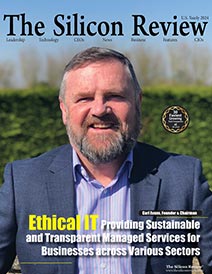50 Most Admired Companies of the Year 2022
Reaching for the stars: Fleet Space Technologies
The Silicon Review
![]()
“Fleet Space has come up with a radical new solution, ExoSphere by Fleet. The world’s first fully vertically-integrated real-time passive seismic imaging system for mineral exploration, it combines satellite connectivity with low-power sensors and machine learning.”
The US spends more on space than all other countries combined. In its latest report, the Bureau of Economic Analysis (BEA) showed that in 2019 alone, the US space economy produced goods and services worth almost US$200 billion, and supported over 350,000 private-sector jobs (NASA, being a government agency, doesn’t show up in these figures).
Equally, there are plenty of ambitious non-US companies eager to get in on the action. One of the world’s fastest-emerging space economies is Australia, where the federal government predicts the industry will triple in size and create an additional 20,000 jobs by 2030. Australian State governments are investing millions of dollars in new facilities for start-ups and more established operators. Foremost among these is Adelaide Space Park - Australia’s first dedicated space manufacturing hub, soon to be home to many Australian Space companies, and the focal point of South Australia’s drive to position itself as ‘the Space State’.
Fleet Space Technologies, which has its global HQ in Adelaide, South Australia, exemplifies the companies, and attitudes, that underpin Australia’s rapid rise as a serious player. Founded by (literal) rocket scientist Flavia Tata Nadini and entrepreneur Matt Pearson in 2015, Fleet Space is a genuine pioneer in the field of small-scale low earth orbit (LEO) satellites. At Fleet, the vision is to connect the Earth, Moon, and Mars. It has a team that has rapidly grown to over 80 employees in the last six months. Fleet designs, builds, and operates a constellation of microsatellites that delivers universal connectivity across the globe. Following an oversubscribed Series-B funding round, Fleet will continue to build a constellation of 288 satellites.
The company already has a number of significant achievements to its name, including launching Australia’s first constellation of commercial satellites, and producing the world’s first all-3D-printed metal patch antenna and it’s currently developing Alpha, the first microsatellite to be fully 3D-printed.
Arguably, its most important innovation is ExoSphere. Currently, the only system of its kind in existence, ExoSphere is transforming the process of discovering and measuring new deposits of commercially-valuable minerals, including those now proving essential in the fight against climate change.
In its World Energy Outlook 2021, the International Energy Agency (IEA) suggests that overall global mineral requirements for clean energy technologies will double by 2040. Batteries for electric vehicles (EVs) require lithium, nickel, cobalt, manganese, and graphite: the permanent magnets essential in wind turbines and EV motors need rare earth elements; while all electrical systems need copper and aluminium.
![]()
But it also states that achieving the Paris Agreement target of ‘well below 2°C global temperature rise’ would take a quadrupling of current resources, while to hit net zero globally by 2050 would require six times more mineral inputs in 2040 than today. The International Monetary Fund (IMF) calculates that lithium and other minerals valued at $13trillion will be required to enable the widespread transition to clean technologies, in pursuit of global net-zero targets.
The industrial and political pressure on the global mining industry to increase output is, therefore, enormous. Unfortunately, this surging demand has coincided with a worldwide slump in new mineral discoveries. Indeed, the most easily-accessible deposits – those in established mining regions and at shallow depths – have been largely identified and exploited.
With finding new sources becoming ever more complex and costly, the mining industry has an urgent need for new ways to identify deposits deeper underground. Mining prospectors have long used seismic imaging; but their technique relies on ‘active’ seismic sources, such as vibrating trucks or explosives, which are expensive and difficult to use in remote or environmentally sensitive areas. ‘Passive’ seismic imaging using dense surface arrays provides a low-cost, environmentally-friendly alternative; its application so far has been constrained by insufficient computing power, and a lack of detailed algorithms and machine learning to process and cross-correlate seismic data.
With ExoSphere, Fleet Space has come up with a radical new solution. The world’s first fully vertically-integrated passive seismic imaging system for mineral exploration, it combines satellite connectivity with low-power sensors and machine learning.
Developed and built in Adelaide, ExoSphere comprises two basic elements. The Geode is a portable device containing a highly sensitive seismic sensor that collects data at depths of up to 2km through ambient noise tomography (ANT). Rugged and durable, it’s compact and light enough to be carried by one person, making it ideal for use in rough and remote terrain.
A transmitter then sends pre-processed real-time passive seismic recordings to Fleet Space’s constellation of LEO satellites. This data is then relayed to computers that use machine learning to generate detailed 3D subsurface maps. Unlike traditional prospecting methods, which can take months to complete, generating a 3D subsurface mapping takes as little as four days.
ExoSphere’s unique combination of Geodes and satellite connectivity allows small teams to map vast amounts of land accurately, and with little to no environmental disturbance. Cross-referencing the data with information from environmental survey satellites also helps identify new mining locations that will minimise ecological damage.
The system has already been adopted by customers, including Oz Minerals, Talon Metals, and Core Lithium. In 2022, Fleet Space completed highly successful field trials with one of Australia’s leading lithium mining companies, Core Lithium, at the flagship Finniss Project near Darwin, Northern Territory. This led to a new contract, due to start in May 2023, which will see ExoSphere deployed across Core’s tenements in Australia.
![]()
In September this year, Talon Metals and Fleet Space announced a pilot trial on their ExoSphere solution at Talon’s exploration projects in Minnesota and Michigan. Talon is exploring high-grade nickel deposits in the United States to supply the domestic battery supply chain with nickel and other battery materials required in the energy transition.
For founder Flavia Tata Nardini, it’s these real-world applications that make space such an endlessly fascinating arena. “At Fleet Space, we are helping solve one of the greatest global challenges. Our innovative technology is already finding applications to make the search for critical energy transition minerals more economical, faster, and much more sustainable. The global space industry is advancing extremely rapidly and the opportunities are enormous: it’s incredibly exciting to be part of this.”









